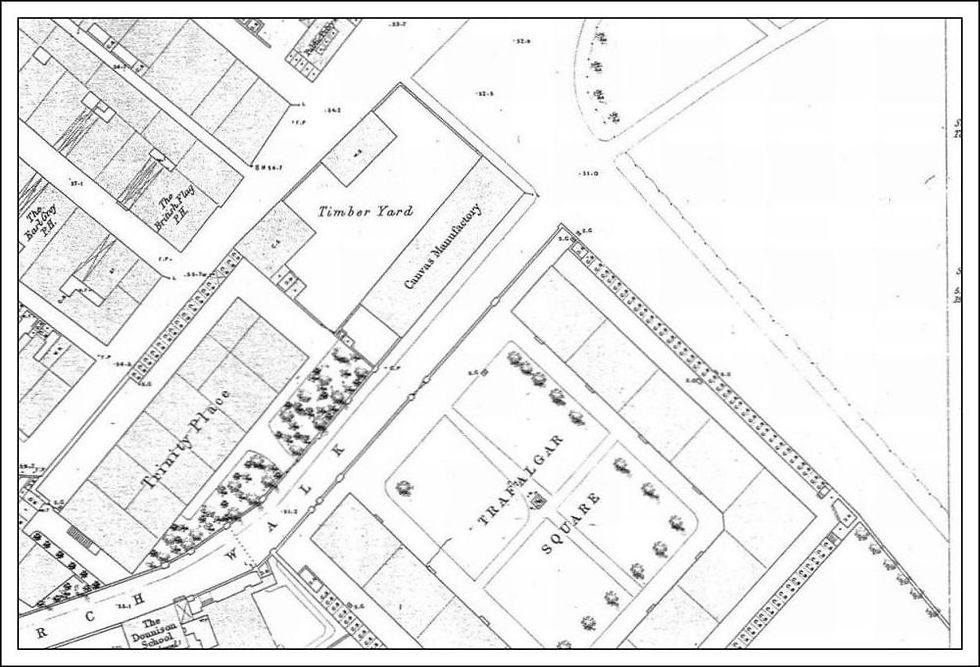



Explore Discover Enjoy
Location 13: Church Walk
We now turn left at what was The Prospect Mission which dates from 1885 operating as a children’s mission
...A children's mission since 1885. This was the first public building to have outward opening doors following the Victoria Hall Disaster of 1883 when 183 children were crushed to death. Tyne and Wear Archives has the mission recorded as Presbyterian. It holds baptism records from 1907 to 1964 and communicants rolls from 1904 to 1966. The building is known as the Bethesda Chapel. The last use of the building was an amateur boxing club and community centre.
As you walk along the old Church Walk you will see the 14 alms houses, built in1840 through The Seaman’s Fund provided by William Drysdale for the Trustees of the Muster Roll to house aged merchant seamen and their wives and widows. This development is 14 houses arranged into flats.
At the centre of the square you will see a decorative high relief painted plaque with sailor and lion supporting escutcheons and maritime symbols, and inscription :
TRAFALGAR SQUARE, ERECTED BY TRUSTEES OF THE MUSTER ROLL ANNO DOMINI 1840, UNDER 4TH AND 5TH of WILLIAM IV, with names of trustees. Well-carved low relief Roman Capitals on eaves band ENGLAND EXPECTS EVERY MAN TO DO HIS DUTY. Trafalgar Square occupies the site of what was the workhouse garden.
The history of alms houses stretches back to medieval times when religious orders cared for the poor. Originally called hospitals or Bede houses, in the sense of hospitality and shelter. The oldest alms house foundation still in existence is thought to be the Hospital of St. Oswald in Worcester founded circa 990.
https://www.almshouses.org/history-of-almshouses/
The Donnison School 1798
Further on the walkway you will see The Donnison School for girls. This rare grade II listed charity school was built in 1798. It encompasses the Georgian and Victorian period of education. The Donnison School was founded by the benefactress Elizabeth Donnison through her will dating from 1777. Elizabeth Donnison bequeathed £1,500 for the formation of a girl’s school in the old parish of Sunderland. A school was established off site initially and then the school found a permanent home in what was to become known as The Donnison School Building and it operated as a school until 1918. The headmistress’s house was an 1827 addition made possible by Elizabeth Woodcock who bequeathed £1000 for its development.
The original school offered free education for 36 poor girls between the ages of seven and sixteen. They were taught religious knowledge, reading, writing and arithmetic, spinning, sewing and knitting and were provided with clothing and shoes. Each girl received a full suit of clothing at Christmas, a part suit at midsummer, and two pairs of shoes. Although teaching at the school ceased at the turn of the last century, samplers made by two Donnison pupils, Elizabeth and Charlotte Green, still exist in the hands of their Granddaughters today. Copies can be seen hanging on the schoolroom wall along with a portrait of Charlotte.
Elizabeth was born on the 21st April 1882 and Charlotte 5th April 1884. They lived in the Pans Bishopwearmouth, and were the youngest of six children. Their father was a shipwright and they lived comfortably until he died during the Christmas of 1891 aged 47. The family were left with very little money so their mother was happy to have them accepted into the Donnison School. The girls were aged 7 and 9 when they became pupils and stayed on until they were 16. Sadly, by this time they had been made orphans as their mother had also passed away.
The building was re-opened in 2007 after an extensive restoration scheme for its new owner Living History North East.
http://www.donnisonschoolheritagecentre.com/
Sunderland Workhouse
Directly opposite the site of The Donnison School stood Sunderland workhouse, an institution established as a safety net for the poor in the parish of Sunderland.
The 1834 Poor Law Amendment
In 1834 the Poor Law Amendment Act was passed by Parliament. This was designed to reduce the cost of looking after the poor as it stopped money going to poor people except in exceptional circumstances. Now if people wanted help they had to go into a workhouse to get it. The poor were given clothes and food in the workhouse in exchange for several hours of manual labour each day.
Sunderland's first parish workhouse was built by public subscription in 1740. It was located in Church Walk (later Trinity Place) near to the Parish Church.
In 1790, a Local Act of parliament was passed which acknowledged that Sunderland was "of small extent but very populous, and the poor of, and belonging to, the said Parish have much increased and are increasing, whereby the usual rates upon the inhabitants of the parish are wholly inadequate to the support of the poor of the said parish of Sunderland.”
According to a parliamentary report of 1777, the workhouse at Sunderland could house up to 90 inmates. In 1779, a labour yard was later added, and the building was extended.
The workhouse inmates were provided with work in spinning and weaving at a 'Sail Cloth Manufactory' erected at Moor Edge, and later the site of St John's Vicarage. Pauper children were also employed in the manufacturing of pins. Reputed at one time to be home to over 600 inmates, by May 1827 there were about 200.



